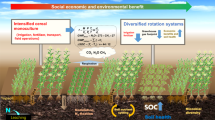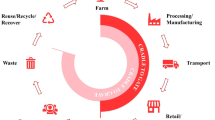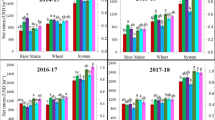Abstract
China produces half of the world’s vegetables. The production uses 1.7% of the global harvest area of crops but accounts for 7.8% of the chemical fertilizers and 6.6% of crop-sourced greenhouse gas (GHG) emissions worldwide. Using an innovative management programme, the integrated knowledge and products strategy (IKPS), we demonstrate opportunities for producing more vegetables with lower environmental impacts in China’s vegetable production systems. Combining soil–crop system management practices with enhanced-efficiency fertilizer products, IKPS was tested through 54 site-year field experiments in China’s major agro-ecological zones by a national research network over 12 years. Compared with current farming practices, the adoption of IKPS decreased the nitrogen (N) application rate by 38%, N surplus by 65% and GHG emissions by 28%, while increasing yield by 17%. Scenario analyses showed that adoption of IKPS in China’s vegetable production could mitigate resource and environmental burdens while enhancing food and nutrition security.
This is a preview of subscription content, access via your institution
Access options
Access Nature and 54 other Nature Portfolio journals
Get Nature+, our best-value online-access subscription
$29.99 / 30 days
cancel any time
Subscribe to this journal
Receive 12 digital issues and online access to articles
$119.00 per year
only $9.92 per issue
Buy this article
- Purchase on Springer Link
- Instant access to full article PDF
Prices may be subject to local taxes which are calculated during checkout



Similar content being viewed by others
Data availability
All of the data that support the findings of this study are available from the corresponding authors upon request.
References
Zhang, X. et al. Managing nitrogen for sustainable development. Nature 528, 51–59 (2015).
Granados, M. R. et al. Prescriptive–corrective nitrogen and irrigation management of fertigated and drip-irrigated vegetable crops using modeling and monitoring approaches. Agr. Water Manag. 119, 121–134 (2013).
Tei, F. et al. Nitrogen management of vegetable crops. Agr. Water Manag. 240, 106316 (2020).
Thompson, R. B. et al. Strategies for optimal fertiliser management of vegetable crops in Europe. Acta Hortic. 1192, 129–140 (2018). https://doi.org/10.17660/ActaHortic.2018.1192.15
Li, T. Y. et al. Enhanced-efficiency fertilizers are not a panacea for resolving the nitrogen problem. Global Change Biol. 24, 511–521 (2018).
National Bureau of Statistics of China China Statistical Yearbook (China Statistics Press, 2016).
Geisseler, D. et al. Nitrogen in soil and subsurface drip-irrigated processing tomato plants (Solanum lycopersicum L.) as affected by fertilization level. Sci. Hortic. 261, 108999 (2020).
Bai, X. et al. Strategies to mitigate nitrate leaching in vegetable production in China: a meta-analysis. Environ. Sci. Pollut. Res. 27, 18382–18391 (2020).
FAOSTAT Food and Agriculture Data (FAO, 2016); http://www.fao.org/faostat/en/#home
Zhang, W. F. et al. China Fertilizer Development Research Report [In Chinese] (China Agricultural Univ. Press, 2016).
Chen, X. P. et al. Producing more grain with lower environmental costs. Nature 514, 486–489 (2014).
Heffer, P., Gruère, A. & Roberts, T. Assessment of Fertilizer Use by Crop at the Global Level (International Fertilizer Association (IFA) and International Plant Nutrition Institute (IPNI) Press, 2017).
Nett, L. et al. Effect of winter catch crops on nitrogen surplus in intensive vegetable crop rotations. Nutr. Cycl. Agroecosyst. 91, 327–337 (2011).
Ju, X. T., Kou, C. L., Zhang, F. S. & Christie, P. Nitrogen balance and groundwater nitrate contamination: comparison among three intensive cropping systems on the North China Plain. Environ. Pollut. 143, 117–125 (2006).
Mostashari-Rad, F. et al. Energy optimization and greenhouse gas emissions mitigation for agricultural and horticultural systems in Northern Iran. Energy 186, 115845 (2019).
Carlson, K. M. et al. Greenhouse gas emissions intensity of global croplands. Nat. Clim. Change 7, 63–68 (2017). https://doi.org/10.1038/nclimate3158
Cui, Z. L. et al. Pursuing sustainable productivity with millions of smallholder farmers. Nature 555, 363–366 (2018). https://doi.org/10.1038/nature25785
Lv, H. et al. Drip fertigation significantly reduces nitrogen leaching in solar greenhouse vegetable production system. Environ. Pollut. 245, 694–701 (2019).
Min, J., Zhang, H. & Shi, W. Optimizing nitrogen input to reduce nitrate leaching loss in greenhouse vegetable production. Agric. Water Manag. 111, 53–59 (2012).
Chen, X. P. et al. Optimizing soil nitrogen supply in the root zone to improve maize nitrogen management in China. Soil Sci. Soc. Am. J. 74, 1367–1373 (2010).
Zhang, B. G. et al. Reducing nitrogen leaching in a subtropical vegetable system. Agr. Ecosyst. Environ. 241, 133–141 (2017).
World Development Indicators 2013 World Bank Publication No. 178; 4375–4381 (World Bank, 2014).
Frei, B., Birlouez-Aragon, I. & Lykkesfeldt, J. Authors’ perspective: what is the optimum intake of vitamin C in humans? Crit. Rev. Food Sci. 52, 815–829 (2012).
Foley, J. A. et al. Solutions for a cultivated planet. Nature 478, 337–342 (2011). https://doi.org/10.1038/nature10452
Hartz, T. K. & Smith, R. F. Controlled-release fertilizer for vegetable production: the California experience. HortTechnology 19, 20–22 (2009). https://doi.org/10.21273/HORTSCI.19.1.20
Seufert, V. & Ramankutty, N. Many shades of gray—the context-dependent performance of organic agriculture. Sci. Adv. 3, e1602638 (2017).
Schader, C., Stolze, M., Gattinger, A. in Green Technologies in Food Production and Processing (eds Boye, J. I. & Arcand, Y.) 183–210 (Springer, 2012).
Zhang, W. F. et al. Closing yield gaps in China by empowering smallholder farmers. Nature 537, 671–674 (2016).
Springmann, M. et al. Options for keeping the food system within environmental limits. Nature 562, 519–543 (2018).
Gustavsson, J. et al. Global Food Losses and Food Waste: Extent, Causes and Prevention (FAO, 2011).
Bremner, J. M. & Tabatabai, M. A. Use of an ammonia electrode for determination of ammonium in Kjeldahl analysis of soils. Commun. Soil Sci. Plant 3, 159–165 (1972).
Holland, E. et al. in Standard Soil Methods for Long-Term Ecological Research (eds Robertson, G. P. et al.) 185–201 (Oxford Univ. Press, 1999).
Denmead, O. T. in Gaseous Loss of Nitrogen from Plant–Soil Systems (eds Freney, J. R. & Simpson, J. R.) 133–157 (Martinus Nijhoff, 1983).
Braschkat, J. et al. Measurement of ammonia emissions after liquid manure application: I. Construction of a wind tunnel system for measurements under field conditions. Z. Pflanz. Bodenkunde 156, 393–396 (1993).
Lehmann, J. & Schroth, G. in Trees, Crops and Soil Fertility: Concepts and Research Methods (eds Schroth, G. & Sinclair, F. L.) 151–166 (CAB International, 2003).
Zhao, R. et al. Nitrogen cycling and balance in winter wheat–summer maize rotation system in Northern China [in Chinese]. Acta Pedol. Sin. 46, 684–697 (2009).
Wang, X. et al. Nitrate leaching from open-field and greenhouse vegetable systems in China: a meta-analysis. Environ. Sci. Pollut. Res. 25, 31007–31016 (2018).
Wang, X. et al. Nitrous oxide emissions in Chinese vegetable systems: a meta-analysis. Environ. Pollut. 239, 375–383 (2018).
Van Groenigen, K. J. et al. Increased greenhouse-gas intensity of rice production under future atmospheric conditions. Nat. Clim. Change 3, 288–291 (2013).
IPCC Climate Change 2014: Impacts, Adaptation and Vulnerability (eds Field, C. B. et al.) (Cambridge Univ. Press, 2014).
De Klein, C. et al. in IPCC Guidelines for National Greenhouse Gas Inventories Ch. 11 (National Greenhouse Gas Inventories, 2006).
Smith, P. et al. in Climate Change 2007: Mitigation of Climate Change (eds Metz, B. et al.) 497–540 (Cambridge Univ. Press, 2007).
Environmental Management—Life Cycle Assessment—Principles and Framework ISO 14040 (International Organization for Standardization, 2006).
National Bureau of Statistics of China National Agricultural Products Cost-benefit Data Compilation (NAPCDC) (China Statistics Press, 2001–2016).
Acknowledgements
This work was financially sponsored by the State Cultivation Base of Eco-agriculture for Southwest Mountainous Land (Southwest University), the Innovation Team in Priority Areas of Non-point Pollution Prevention in the Three Gorges Reservoir Area, China and the National Key Research and Development Program of China (2017YFD0800403). We thank P. Vitousek (Stanford University) and J. D. Toth (University of Pennsylvania) for valuable comments and language editing assistance.
Author information
Authors and Affiliations
Contributions
X.C. and Fusuo Zhang designed the research. X.W., X.S., C.Z., Z.W., B.Z., Y.S., J.L., B. Liang, L.T., L.J., Z.S., J.Y., X.G., D.S., B. Liu, G.W. and H.Z. conducted the field experiments. X.W., X.G., D.L., Fen Zhang, W.Z. and B. Liu collected and analysed the data. X.C., X.W. and Z.D. wrote the manuscript.
Corresponding authors
Ethics declarations
Competing interests
The authors declare no competing interests.
Additional information
Peer review information Nature Food thanks David Makowski, Paul Kristiansen and Steffanie Scott for their contribution to the peer review of this work.
Publisher’s note Springer Nature remains neutral with regard to jurisdictional claims in published maps and institutional affiliations.
Supplementary information
Supplementary Information
Supplementary Figs. 1–8 and Tables 1–5.
Supplementary Data 1
Supplementary reference lists for the database of vitamin C concentrations in different vegetables (edible parts only) in China; the database of establishing NH3 volatilization models for open-field and greenhouse systems; and N2O emissions, N leaching and NH3 volatilization from EEFs including nitrification inhibitor and controlled-release fertilizer.
Rights and permissions
About this article
Cite this article
Wang, X., Dou, Z., Shi, X. et al. Innovative management programme reduces environmental impacts in Chinese vegetable production. Nat Food 2, 47–53 (2021). https://doi.org/10.1038/s43016-020-00199-0
Received:
Accepted:
Published:
Issue Date:
DOI: https://doi.org/10.1038/s43016-020-00199-0
This article is cited by
-
Up-bottom assessments of nutrient supply and gaseous pollutant from Chinese wheat straw field management
Scientific Data (2024)
-
Organizational support, market access, and farmers’ adoption of agricultural green production technology: evidence from the main kiwifruit production areas in Shaanxi Province
Environmental Science and Pollution Research (2024)
-
Dissolved N and C leaching losses mitigated by optimized fertilization management in intensive greenhouse system: insights from DOM characteristics via EEM-PARAFAC
Journal of Soils and Sediments (2023)
-
Balancing high yields and low N2O emissions from greenhouse vegetable fields with large water and fertilizer input: a case study of multiple-year irrigation and nitrogen fertilizer regimes
Plant and Soil (2023)
-
A precision compost strategy aligning composts and application methods with target crops and growth environments can increase global food production
Nature Food (2022)



